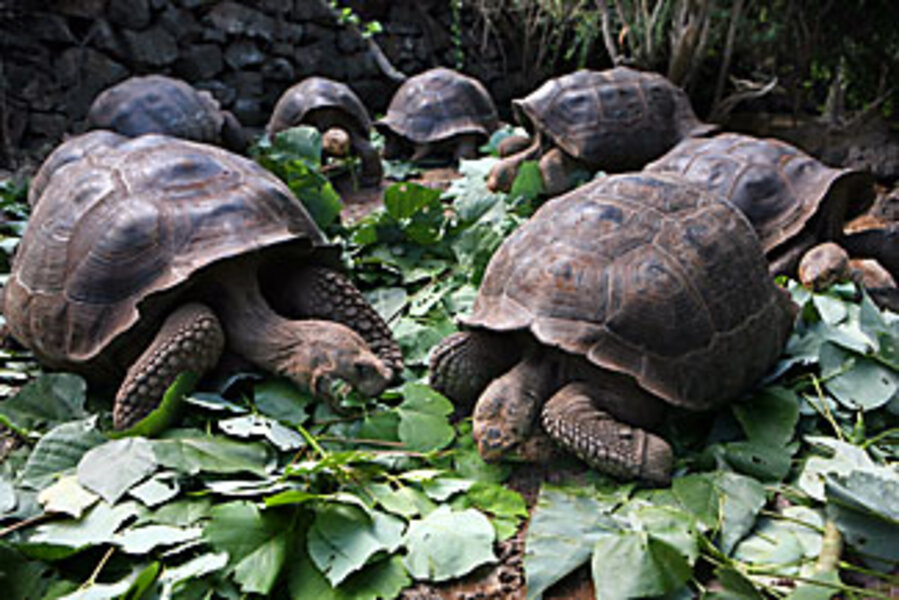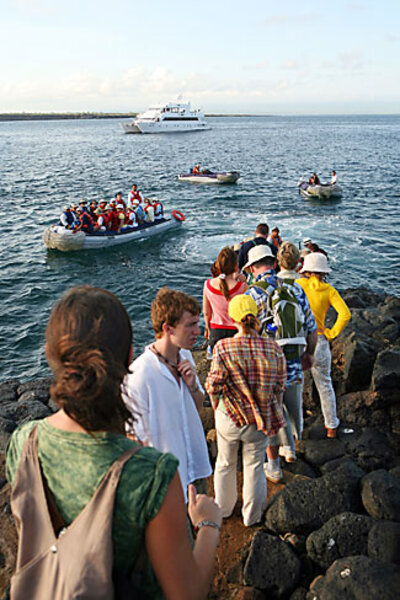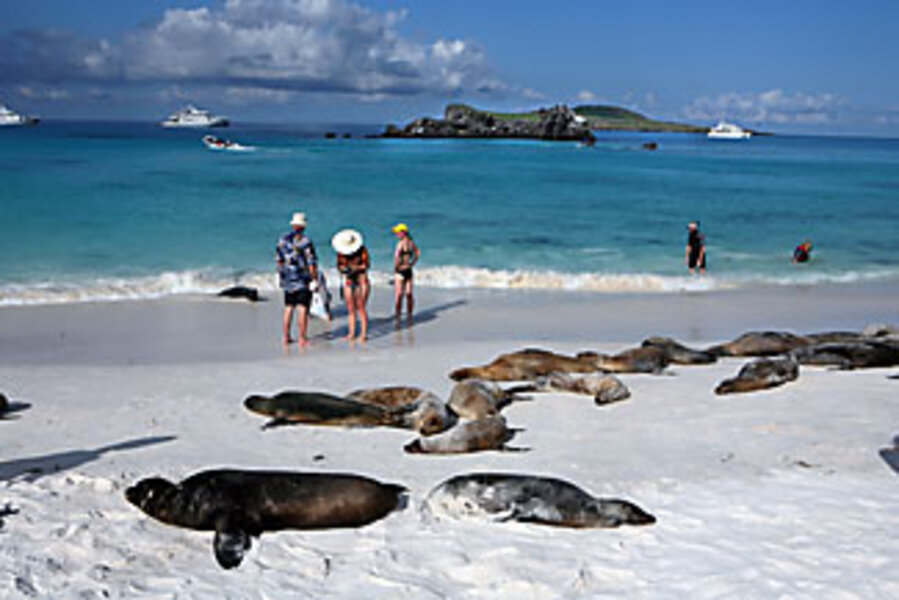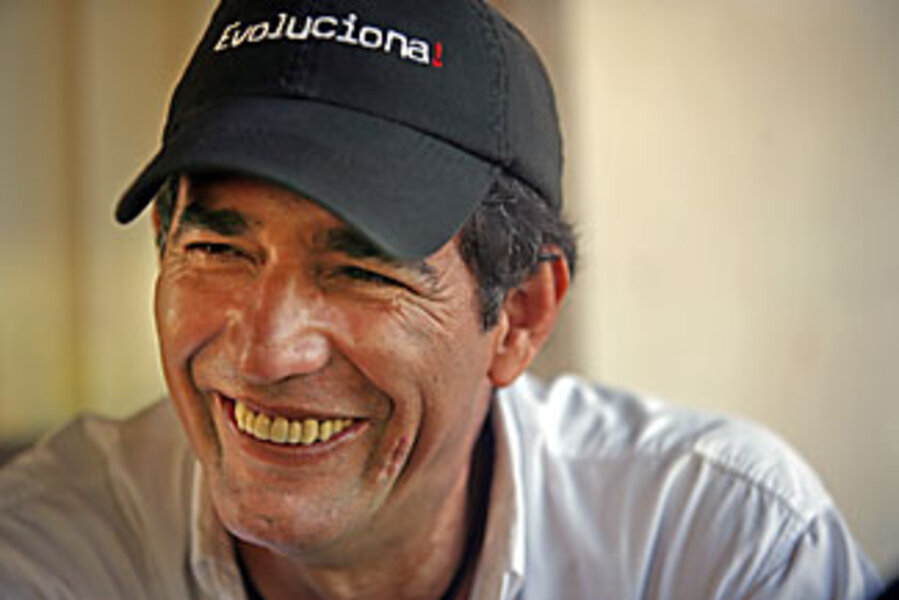Saving the Galapagos means rebuilding nature
Loading...
| Galápagos, Ecuador; and New York
Here, where three Pacific currents swirl together 600 miles from mainland Ecuador, the Galápagos Islands, a chain of dead and active volcanoes, rise from the sea. The archipelago is among the most biologically unique spots on Earth – nature's laboratory, the biologists' mecca that catalyzed Charles Darwin's theory of natural selection.
Five centuries after Europeans first set foot here – and following successive waves of pirates, whalers, colonists, and tourists – the islands retain 95 percent of their native flora and fauna. But as the world celebrates the 200th anniversary of the birth of Charles Darwin and the 150th anniversary of his "The Origin of Species," that triumph is tenuous.
Tourism has quadrupled in recent decades, and since 1991, immigrants seeking a better life have doubled the population. But the greatest threat to the Galápagos is plants and animals that people have brought. Newly arrived species often out-compete – or simply eat – native flora and fauna, driving them out of existence. Even a tiny mainland mosquito carrying disease has a huge domino effect.
Here, as in many other parts of the world, it's simply too late to set aside bits of land and sea and hope for the best. This isn't a "pristine" ecosystem. It's already radically altered by humans and their attendant goats, pigs, dogs, and rats.
Conservation here isn't so much setting an area off-limits, it's restoration – scrubbing the environment of what doesn't belong and rebuilding ecosystems to approximate their former selves.
CAN YOU REALLY put nature back together again? If anyone can, it's someone with the brash charm and frenetic energy of Felipe Cruz. A native Galápagan as addicted to his Blackberry as he is to the pull of the caves and nests he explored in his barefoot boyhood on Floreana Island, he already has revolutionized rat and goat eradication, a first step in rebuilding an ecosystem.
As the chief architect of Project Floreana – an unprecedented plan to restore a whole island ecosystem – he's an environmental Renaissance man. A director of the Charles Darwin Foundation (CDF), he's the go-to guy for international scientists – a trained biologist who speaks their technical language but seems unable to resist noting that "since I was 22 I have been the boss of gringos." He's a hands-on conservationist, boasting that Prince Philip of England personally consulted him about Buckingham Palace rats after hearing of his talent for eradication. He's also a Galápagos insider – among his 11 siblings are a former governor of the islands and a former Galápagos National Park director – respected up and down the social ladder of the island community, even if his job occasionally makes him a political target of everything from rioters' rocks to telephoned death threats.
Certainly, reconstructing nature is a prospect fraught with contradictions. Can it really be natural if it is created by human design?
Cruz and fellow conservationists operate on a simple formula: If an ecosystem is a community of life forms that have evolved together and achieved equilibrium, then the restoration of that ecosystem begins with the removal of everything that upsets the balance. And so, somewhat paradoxically, the conservation of Galápagan ecosystems inevitably starts with a meticulous campaign of eradication. Animals introduced by people must go. Once the slate is wiped clean, native species, some of which continue to exist only in captivity – like Lonesome George, the iconic giant tortoise who's the last of his breed – can be reintroduced. Then the community, a system of checks and balances honed to perfection over time – of grazing tortoises and plants, birds and seeds that need each other – can reestablish.
The wildcard: that other invasive species – Homo sapiens. How to prevent people – residents seeking a livelihood and outsiders seeking adventure – from undoing a Herculean undertaking. How to balance humanity's day-to-day needs with the existence of living things found nowhere else on Earth.
"What we need is holistic island restoration, here and in islands around the world," explains Cruz. "We want to learn how to do this properly here and then scale it up to ... the rest of the world."
Restoration is daily work in the Galápagos. Park rangers do constant battle poisoning rats and fumigating plants that strangle native flora. But the Floreana Project, sponsored by the CDF, the Galápagos National Park Service, and other partners, takes restoration to a new scale: an unprecedented islandwide approach. That means ridding the entire 67-square-mile island of invasives, reintroducing species, and bringing locals on board.
Floreana will never be the island of Cruz's childhood, but if its biodiversity isn't restored now, he says, it will be lost forever.
CRUZ'S PARENTS MIGRATED from mainland Ecuador, settling on Floreana in the 1940s after finding nearby San Cristobal Island too crowded (it had 300 people). On Floreana they farmed – lemons, pineapples, corn, papayas – and raised a family in the wholesome isolation of nature that captured Cruz's imagination. His father read Kafka and Shakespeare aloud and told his own tales – including the story of the extinction of the dodo bird.
In early signs of his quixotic pursuit of "the impossible," Cruz refused to believe the flightless pigeon (never a Galápagos resident) was extinct, and with a child's naiveté set out to find the bird in the crevices across the island. Instead, he discovered the nests of the endangered Galápagos petrel, a tube-nosed seabird. Camping atop Cerro Pajas – Bird Hill, the highest point on Floreana, at 2,000 feet – the young Cruz would fall asleep to the purring sounds of petrels in their nests among the rocks. It was the background music to an obsession that led him to study biology at university in Quito.
Cruz embraced restoration early: "I realized that in order to save my birds, I was not going to help them by being a scientist. I needed to get rid of the lizards, rats, and dogs. I had to do the dirty work."
A benign presence elsewhere, here goats denude entire islands. Pigs and rats eat bird eggs and nestlings. Feral cats prey on marine iguanas. There are 1,200 plants in Galápagos; only 500 are native. The most innocuous American backwoods species – think blackberries – are major threats here.
"[The effect of] introduced species is very real and very dramatic," explains Godfrey Merlen, a longtime Galápagos conservationist. "There is no issue more important than introduced species. It will decide the fate of the Galápagos."
One victim of invasives is the Floreana mockingbird, a subspecies Darwin collected and pondered in his questioning of the immutability of species. One of the rarest birds in the world, it was extirpated from Floreana – only 470 survive on two nearby islets. Its demise is directly traced to rats and feral cats as well as to goats and nonnative plants that destroy or overtake habitat. With fewer mockingbirds dispersing cactus seeds, fewer cacti grow.
The Galápagos National Park, the CDF, and others have logged major successes against invasives. Cruz oversaw the eradication of 62,818 goats on Isabela Island between 2004 and 2006. Lauded as the largest mammal eradication in history, Project Isabela perfected a process – using sharpshooters in helicopters and the release into the wild of sterile goats – likely to be adopted elsewhere.
"It revolutionized eradication in some ways," says Josh Donlan, executive director of Advanced Conservation Strategies in Midway, Utah. Skeptics thought the size of Isabela, about that of Rhode Island, would be insurmountable, he says.
"We proved we could do this, after the world said it was impossible," says Cruz.
Trucking up Floreana's Bird Hill like a goat, recently, Cruz paused to look down on a maze of paths he'd cut singlehandedly with a machete 30 years ago while carrying 90-pound packs of rat poison so that his petrel birds could thrive. "Because of that project, I saved them from extinction," he says. "I honestly do not know how I did it."
But he's about to go further: The blitz of rat and feral cat eradication and invasive-plant fumigation will be islandwide. And residents and tourists will be severely restricted on plant and animal imports. This project, once again, will entail many "firsts."
"Rat eradication has never been carried out islandwide on an island this size," Cruz says.
A SMALL-SCALE WAR has simmered between locals and conservationists. In an archipelago that many outsiders don't realize is home to 30,000 people – up from 4,000 in the 1970s – a type of lawlessness described by park rangers as "terrorism" has reigned. It's been mostly perpetrated by fishermen, angry at quotas and restrictions placed on their catches. CDF offices have been looted, scientists have been verbally and physically attacked, and a warden was shot in 1997. Even Lonesome George, the last known Pinta Island tortoise and an icon of conservation in Galápagos, has been threatened.
Cruz, himself an iconic figure of conservation here, has been threatened too. Locals who hunt goat for meat bitterly protested his eradication campaign and accused him of pocketing their livelihoods.
In 2007, tensions reached new highs when Cruz publicly called for caps on the numbers of tourists descending on Galápagos. Anonymous voice mails flooded in: "Accidents happen all the time…."
Luis Bonilla, president of the area fishing cooperative, is unapologetic about resident antipathy for conservation: "You can stick a knife in someone, and no one does anything. But you throw a little pebble at an animal and you go to jail."
But these animals draw business of all kinds here. Between 1990 and 2008, the number of visitors to the islands jumped from 40,000 to 170,000. Tourists not only require more fuel and food, but attract more migrants from the mainland seeking opportunity. The government has cracked down on migration – with immigration laws stricter than those in the US (babies born here do not automatically gain residency) – but many say that until tourism is tamed, the population will surge.
"No one even contemplates the simple idea of capping the number of tourists," says CDF social scientist Christophe Grenier, complaining that tour operators making shorter trips with more visitors "sell the Galápagos like a catalog of animals."
A new model drawing tourists who have more money and time is preferred to caps, says Oscar Aguirre, of the Chamber of Tourism in Galápagos. It's not that Galápagos rejects budget backpackers, he says. But he is clear: "We don't want just any tourist here. We want tourists with money."
Tourism will be a key test on Floreana. The island is sleepy, with dirt roads and ramshackle homes that empty out during the day as residents head to the highlands to farm. Until recently, it was not on the tour circuit. But today about three boats of daytrippers dock each day. And developers have inquired about land, tempting a local population that desperately wants more investment.
Cruz isn't opposed – but wants proceeds and opportunity distributed evenly. "Shhhh," he says, laughing, when it's noted that his brother, standing nearby, has a small "monopoly" on Floreana, owning three of the nine cars permitted there and one of two hotels.
Project Floreana also aims to work with the locals, educating farmers on invasive plants and how to increase agricultural output so that the island is less import-dependent. Residents will have to neuter cats and weed gardens.
"The first thing you have to think about is people. [The influence of] invasives are a people problem," says Rachel Atkinson, a restoration coordinator at CDF. "Project Isabela was a big testing ground. This is the first time the human element is being tested."
It could be controversial, sparking sentiments that have flashed elsewhere.
"They care more about endemic plants than about us," says Mauricio Alban, a Floreana resident. He's referring to the national park and the CDF, which, although staffed primarily by Ecuadorians, is the gatekeeper for the international community here. For locals, that inspires a rash of nationalism, a feeling that Cruz, the self-described "ambassador" of the Galápagos, says he works to temper. "Some [locals] will say to me, 'Why are you bringing foreigners here? They will tell us what to do.' I say to them, 'They will not tell us what to do, They will tell us what they have done [that we can draw on]' "
ON A RECENT DAY ABOARD a boat hovering near Champion islet off Floreana, Cruz whistles: Two Floreana mockingbirds flutter atop a cactus. His sensitive side emerges as he climbs to the bow to snap photos. Wistfulness aside, he's deeply determined that the mockingbird, which he has seen three times in his life on Floreana – will fly there again.
Species reintroduction is the last piece of the process. Floreana has the smallest population of the four inhabited Galápagos islands – 120 residents. But it was the first to be colonized, in the 1830s, and scientists say it has the most ecosystem degradation. Its giant tortoises, mockingbirds, and other species no longer exist here. Scientists hope to introduce a related tortoise from Isabela, as well as the extinct Floreana racer snake.
With Lonesome George as sad sentinel, Cruz sees no reason to watch the same scenario play out on the archipelago, where 74 species are threatened. "We still have Lonesome George.... It's a pathetic thing that we are actually watching the extinction of that species."
Since Lonesome George, whose ancestors were butchered for food and oil, was found in 1971, scientists have furiously searched for others of his subspecies. Failing that, they've mated him with closely related subspecies. In 2008, one mate laid a clutch of eggs. But they were unfertilized. Today, the 90-year-old lazes in his corral of lava rock and cactus, in the CDF's captive breeding program – a predicament Cruz's "dirty work" aims to prevent for other creatures.
THIS TYPE OF PROJECT DOES raise a question: Isn't the art of ecorestoration just as intrusive as the human footprint itself?
Mr. Merlen, who's spent his life researching here, puts it this way: "Restoration is not seeking to create something different, but put something in order that once existed."
But Cruz is less interested in the fine points. Changing what he can is the goal: "I always feel that I am running behind time. I'm always asking myself, 'Are you doing everything you can to save Galápagos?' "
He's driven by something deeper, passed down from his father – who donated his Floreana home to be a school – and something Cruz wants to pass on to his own 12-year-old son. "The greater good," he calls it.
"We have to live with Damocles's sword on top of our heads that something is going to go wrong and that species are going to disappear here forever," he says. "I feel a big responsibility on my shoulders."








